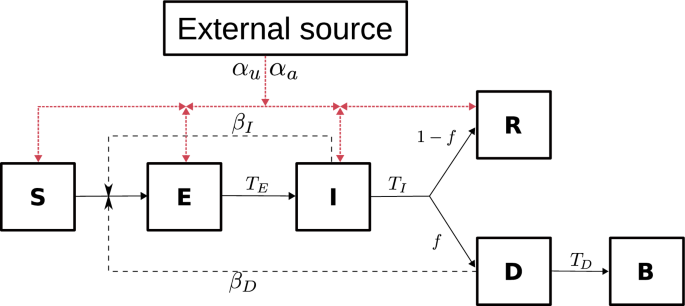Listen to the article
In a world where information flows as freely as the diseases it aims to prevent, scientists are pioneering new approaches to understand how misinformation shapes epidemic outcomes. A groundbreaking study has unveiled a mathematical model that quantifies the competing influences of factual information and misinformation on disease transmission, offering critical insights for public health strategies.
The research expands upon traditional compartmental models in epidemiology, which categorize individuals as susceptible, infected, or removed. While these models have been the cornerstone of disease forecasting since Kermack and McKendrick’s seminal work in 1927, they typically assume infection rates remain constant—an oversimplification that doesn’t account for how information influences behavior.
“Information quality directly impacts prevention behaviors, which in turn affects transmission rates,” explains the research team. “Our model introduces parameters that independently measure the influence of both factual information and misinformation on disease dynamics.”
The model introduces what researchers call the “behavioral-information factor” (BIF), which adjusts infection rates based on the presence of factual information and misinformation in a population. This innovation acknowledges that disease transmission isn’t merely biological—it’s behavioral.
A key finding reveals that misinformation typically persists longer than factual information. The researchers note that sensational, emotionally charged misinformation tends to spread more widely and maintain its influence over extended periods. This matches real-world observations, such as the “salt-water cure” that circulated during the Ebola outbreak, falsely claiming that bathing in and drinking hot salt water could prevent airborne transmission, resulting in hospitalizations and deaths.
The model specifically examines the 2014-2016 Ebola virus disease (EVD) outbreak, using agent-based modeling techniques to simulate 10,000 individuals. Each digital “agent” possesses parameters representing their physical location, disease status, level of factual information, and degree of misinformation.
“What makes this approach unique is that individuals can simultaneously hold both factual information and misinformation,” the researchers explain. “Just as in real life, a person might correctly understand the importance of handwashing while also believing in ineffective or harmful treatments.”
The simulation accounts for information decay over time, reflecting how both accurate information and misinformation lose quality as they pass from person to person. Notably, newly infected individuals automatically receive high-quality factual information about the disease through direct experience—a phenomenon observed in real-world epidemics.
The model distinguishes between the transmission of information from live and deceased individuals, accounting for cultural practices around funeral rites that played a significant role in Ebola transmission. By incorporating these nuances, researchers can better predict how different interventions might alter the trajectory of an outbreak.
Public health implications are substantial. The research suggests that combating misinformation is as critical as disseminating accurate information during disease outbreaks. While protective behaviors can only reduce infection rates to a certain point, harmful behaviors driven by misinformation have potentially unlimited capacity to accelerate transmission.
The model’s versatility extends beyond Ebola. Its framework could be applied to other infectious diseases, including COVID-19, where misinformation has complicated public health responses globally.
“Trust levels in institutions and media significantly impact how a society responds to an epidemic,” the researchers note. “Communities with higher trust tend to maintain awareness longer and implement protective behaviors more consistently.”
This research arrives at a critical juncture, as public health authorities worldwide grapple with the “infodemic” phenomenon—the rapid spread of misinformation that accompanies disease outbreaks. By quantifying how information quality influences disease dynamics, this modeling approach offers a powerful tool for developing more effective communication strategies during public health emergencies.
For policymakers and public health officials, the message is clear: winning the battle against infectious disease requires not just medical interventions, but strategic information campaigns that can counter misinformation while building trust in factual guidance.
Verify This Yourself
Use these professional tools to fact-check and investigate claims independently
Reverse Image Search
Check if this image has been used elsewhere or in different contexts
Ask Our AI About This Claim
Get instant answers with web-powered AI analysis
Related Fact-Checks
See what other fact-checkers have said about similar claims
Want More Verification Tools?
Access our full suite of professional disinformation monitoring and investigation tools




9 Comments
I’m curious to see how this new model could be applied to mining and commodities sectors, where information quality can also influence behavior and market dynamics.
Good point. Misinformation in mining/commodities could sway investment, production, and trade decisions in ways that impact supply and pricing.
I wonder how this model could be adapted to analyze the dynamics of information flow and its effects in other complex systems like global energy or commodity markets.
Interesting that the research builds on classic epidemiological models but introduces new parameters to capture the influence of information. A more holistic approach.
This study highlights the need for robust, trustworthy information dissemination, especially during times of crisis or volatility. Transparency is key.
Absolutely. Mitigating the spread of misinformation should be a priority to ensure markets function efficiently and safely.
Fascinating research on how misinformation can impact disease transmission. Quantifying the effects of factual info vs. misinformation is crucial for effective public health strategies.
An important finding – the ‘behavioral-information factor’ that accounts for how info quality impacts prevention behaviors and transmission rates. Crucial for accurate disease forecasting.
This study underscores the importance of digital literacy and critical thinking skills, especially when it comes to evaluating information sources during times of crisis or uncertainty.